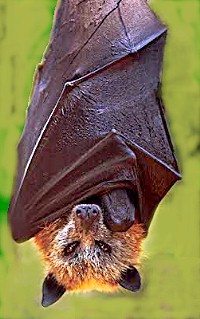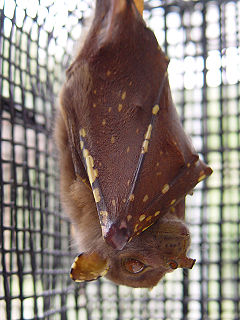
Megabats constitute the family Pteropodidae of the order Chiroptera (bats). They are also called fruit bats, Old World fruit bats, or—especially the genera Acerodon and Pteropus—flying foxes. They are the only member of the superfamily Pteropodoidea, which is one of two superfamilies in the suborder Yinpterochiroptera. Internal divisions of Pteropodidae have varied since subfamilies were first proposed in 1917. From three subfamilies in the 1917 classification, six are now recognized, along with various tribes. As of 2018, 197 species of megabat had been described.

Micronycteris is a genus of leaf-nosed bats.

The Neotropical fruit bats (Artibeus) are a genus of bats within the subfamily Stenodermatinae. The genus consists of 12 species, which are native to Central and South America, as well as parts of the Caribbean.

Acerodon is a genus of bats in the family Pteropodidae containing five species, all native to forests in Southeast Asia, and all considered threatened. They are closely related to Pteropus.

The Honduran fruit-eating bat is a species of bat in the family Phyllostomidae. It is found in El Salvador, Honduras, and Nicaragua.

Dobsonia is a genus of megabat in the family Pteropodidae. It contains the following 13 species:

The São Tomé collared fruit bat is a species of megabat in the family Pteropodidae. It is endemic to São Tomé and Príncipe. Its natural habitats are subtropical or tropical moist lowland forest and subtropical or tropical moist montane forest. It is threatened by habitat destruction. This bat is unique in that it is the only known mammal where the whole population has an asymmetrical dental formula.

The East African little collared fruit bat is a species of megabat in the family Pteropodidae. It is found in Kenya, Tanzania, and Zimbabwe. Its natural habitats are subtropical or tropical dry forests and moist savanna. It is threatened by habitat loss.

The little collared fruit bat is a species of megabat in the family Pteropodidae found in Angola, Cameroon, the Central African Republic, the Republic of the Congo, the Democratic Republic of the Congo, Ivory Coast, Equatorial Guinea, Gabon, Ghana, Guinea, Liberia, Nigeria, Rwanda, Sierra Leone, South Sudan, Togo, and Uganda. Its natural habitats are subtropical or tropical moist lowland forests and moist savanna.

Rhinophylla is a genus of South American bats in the family Phyllostomidae containing these species:

Carolliinae is a subfamily of bats.

The Aru flying fox is a Critically Endangered species of megabat found in the Aru Islands in Indonesia. It was described by Wilhelm Peters in 1867. It was formerly considered a subspecies of the black-bearded flying fox. The species is poorly known, and has not been encountered since the 19th century. It is classified as critically endangered by the IUCN and is listed on CITES appendix II.

Nyctimene is a genus of bats in the Pteropodidae family. Commonly known as tube-nosed fruit bats, they are found in the central Philippines, eastern Indonesia, Papua New Guinea and the north-east coast of Australia.

Thomas's fruit-eating bat, sometimes also popularly called Watson's fruit-eating bat, is a species of bat in the family Phyllostomidae. It is found from southern Mexico, through Central America to Colombia. Its South American range is to the west of the Andes. The species name is in honor of H. J. Watson, a plantation owner in western Panama who used to send specimens to the British Natural History Museum, where Oldfield Thomas would often describe them.
Hepatocystis perronae is a species of parasitic protozoa. They are transmitted by flies of the genus Culicoides and infect mammals.

The steadfast tube-nosed fruit bat is a species of megabat in the family Pteropodidae found in West Papua, Indonesia, and Papua New Guinea.
Paranyctimene is a genus of bats in the family Pteropodidae. They are distributed in Indonesia















